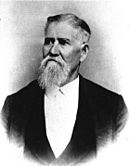Peter G. Stewart facts for kids
Quick facts for kids
Peter Grant Stewart
|
|
|---|---|
 |
|
| Second Executive Committee of the Provisional Government of Oregon | |
| In office 1844–1845 |
|
| Constituency | Oregon Country |
| Personal details | |
| Born | September 6, 1809 New York |
| Died | August 27, 1900 (aged 90) Tacoma, Washington |
| Spouses | Rebecca Rawlings Cason d. 1863 Eliza Rosecrans |
| Occupation | politician, jeweler |
Peter Grant Stewart (born September 6, 1809 – died August 27, 1900) was a jeweler and an early settler, also known as a pioneer. He lived in the Oregon Country, which later became parts of the U.S. states of Oregon and Washington.
Stewart was born in New York state. He traveled the famous Oregon Trail to the Willamette Valley. He first settled in Oregon City. Later, he moved to what is now Washington state. He was a member of the Second Executive Committee of the Provisional Government of Oregon. This was an early government for the settlers. His home later became part of Fort Canby at the mouth of the Columbia River.
Contents
Peter Stewart's Early Life
Peter G. Stewart was born in Stamford, New York, on September 6, 1809. When he was eight years old, in 1817, his family moved to Jefferson, New York. They later moved to Middleburgh, New York. In 1840, he moved to Springfield, Missouri.
During these years, Stewart worked as a jeweler and watchmaker. He married Rebecca Rawlings Cason on September 1, 1842, in Missouri. Rebecca was born in 1826 in Virginia.
Journey on the Oregon Trail
On May 22, 1843, Peter Stewart and his group left Independence, Missouri. They had two wagons and were part of the "Great Migration" of that year. This was a huge journey where many people moved west.
The Stewart group included his new wife and her parents. As they traveled the Oregon Trail, Stewart helped a fellow traveler named James W. Nesmith. They rescued William Vaughn from drowning while crossing the Kaw River.
Many other important people were on this wagon train. Doctor Marcus Whitman from a mission near Walla Walla, Washington was there. So was Jesse Applegate, who would later create the Applegate Trail. They also met Lieutenant John C. Frémont of the United States Army. He was on a mapping mission.
Life in the Oregon Country
Stewart arrived in the Oregon Country in 1843. After a short time, he volunteered to help rescue the Joel Palmer wagon train in 1845. This shows he was helpful to other settlers.
In 1850, while living in Oregon City, Stewart bought land. This land was part of a townsite called Pacific City. It was in what was then Lewis County. He bought it from Elijah White.
Building a Home and Mill
Stewart built an "iron house" and a saw mill on this land. The site was near the entrance of the Columbia River to the Pacific Ocean. It was also close to Cape Disappointment, near today's Ilwaco, Washington. By 1853, he partly owned the Pacific Steam Saw Mill Company there.
Land Taken by the Government
Later in 1853, the United States government took his property. They wanted to use it for a lighthouse and a military base. This base became Fort Canby. At first, the government did not pay Stewart. He only had "squatter's rights" to the land. This meant he didn't officially own it.
Years later, when Stewart was 82, he asked the state of Washington for help. Washington then asked the U.S. Congress to pay Stewart for his loss. Oregon also did the same. In 1891, Oregon Senator John H. Mitchell introduced a bill to pay Stewart. Finally, in 1899, Peter Stewart was paid $7,500 by the U.S. government for his property.
Later Life and Work
After leaving Pacific City, Stewart went back to being a jeweler and watchmaker. He worked in Oregon City from 1854 to 1860. In 1861, he moved to Portland, Oregon. Sadly, his business was destroyed by fire in 1862 and again in 1873.
Between these fires, Peter Stewart's first wife died in 1863. He remarried in 1872 to Eliza Rosecrans. Years later, Peter Stewart moved to Tacoma, Washington. He died there on August 27, 1900, at the age of 90.
Peter Stewart's Role in Government
In May 1844, the pioneer settlers elected Stewart to an important position. He became a member of the Second Executive Committee of the Provisional Government of Oregon. This committee was like an early governing body.
Stewart received 140 votes, placing him second. He was one of three people chosen for the committee. The others were Osborne Russell and William J. Bailey. Peter Stewart served on this committee from May 25, 1844, to July 14, 1845.
After this, the committee was replaced by a single governor. George Abernethy was elected as the first governor. Stewart was then chosen to be the first judge for the District Court of Clackamas County, Oregon. In 1853, he worked as a surveyor for Pacific City. Finally, from 1870 to 1879, Stewart served as the city recorder for Gervais. This town is in the Willamette Valley on French Prairie.
Peter Stewart's Family Life
Peter Stewart's first wife, Rebecca, had important parents. Her father was Fendal Carr Cason, who was a member of the Oregon Territorial Legislature. Her mother was Rebecca Holladay Cason.
Oregon's first territorial recorder, John Long, was Peter Stewart's brother-in-law. Peter Stewart had nine children with his first wife. Their names were Nellie, Margaret, Frederick, James, Katherine, Charles, Catherine, Mary, and George. Sadly, Catherine died during the journey on the Oregon Trail. Nellie, born in 1863, was the youngest child.

